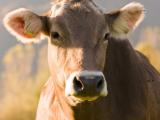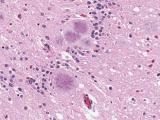Jan 22, 2007 (CIDRAP News) Health officials in the United Kingdom have found a probable fourth case of variant Creutzfeldt-Jakob disease (vCJD) associated with a blood transfusion from someone who unknowingly had the disease.
The case was diagnosed in a patient who received blood 9 years ago from a person who later was found to have vCJD, the UK Health Protection Agency (HPA) said in a Jan 18 statement.
"A transfusion from the same blood donor was also associated with one of the previously identified cases," the HPA said. "The patient is still alive and is under specialist care."
The first case of vCJD associated with a blood transfusion was found in December 2003. So far, authorities have identified 66 people in the United Kingdom who have received "vCJD-implicated" transfusions, of whom 40 have died of causes other than vCJD, the HPA said. Twenty-three people are alive and have not been diagnosed with vCJD.
All 23 people have previously been informed of their potential exposure to the disease and advised to take precautions to reduce the risk of passing it to others via healthcare procedures, such as surgery, the statement said.
"This new case of vCJD infection increases our concern about the risk to the small group of people who had blood transfusions from donors who unknowingly at the time of donation must have had vCJD infection," Peter Borrielo, director of the HPA Centre for Infections, said in the news release. "However, this new case does not change our understanding of the risk for other people in any specific way."
Authorities have classified the new case as probable, since vCJD cannot be definitively diagnosed until after death. Postmortem studies have been done on 112 of the 158 vCJD case-patients who have died, and have confirmed the disease in all cases, the HPA said.
The United Kingdom uses a number of precautions to protect the blood supply from vCJD infectivity, the HPA noted. Since 1997, new cases of vCJD have triggered a search for and destruction of any blood donated by the case-patient. Since 1998 the United Kingdom has used blood plasma from the United States to produce all plasma derivatives. And since October 1999, white blood cells, which may pose the greatest risk of transmitting vCJD, have been removed from blood used for transfusions.
Variant CJD is the human counterpart of bovine spongiform encephalopathy, or mad cow disease, which spread through British cattle herds in the 1980s and 1990s. Most vCJD patients are believed to have acquired the fatal brain disease by eating beef from diseased cattle.
See also:
Jan 18 UK HPA news release
http://www.hpa.org.uk/hpa/news/articles/press_releases/2007/070118_vCJD.htm
Sep 24, 2004, CIDRAP News story "UK tells blood-product recipients about possible vCJD risk"
Jul 22, 2004, CIDRAP News story "Another UK patient may have caught vCJD from blood"

















